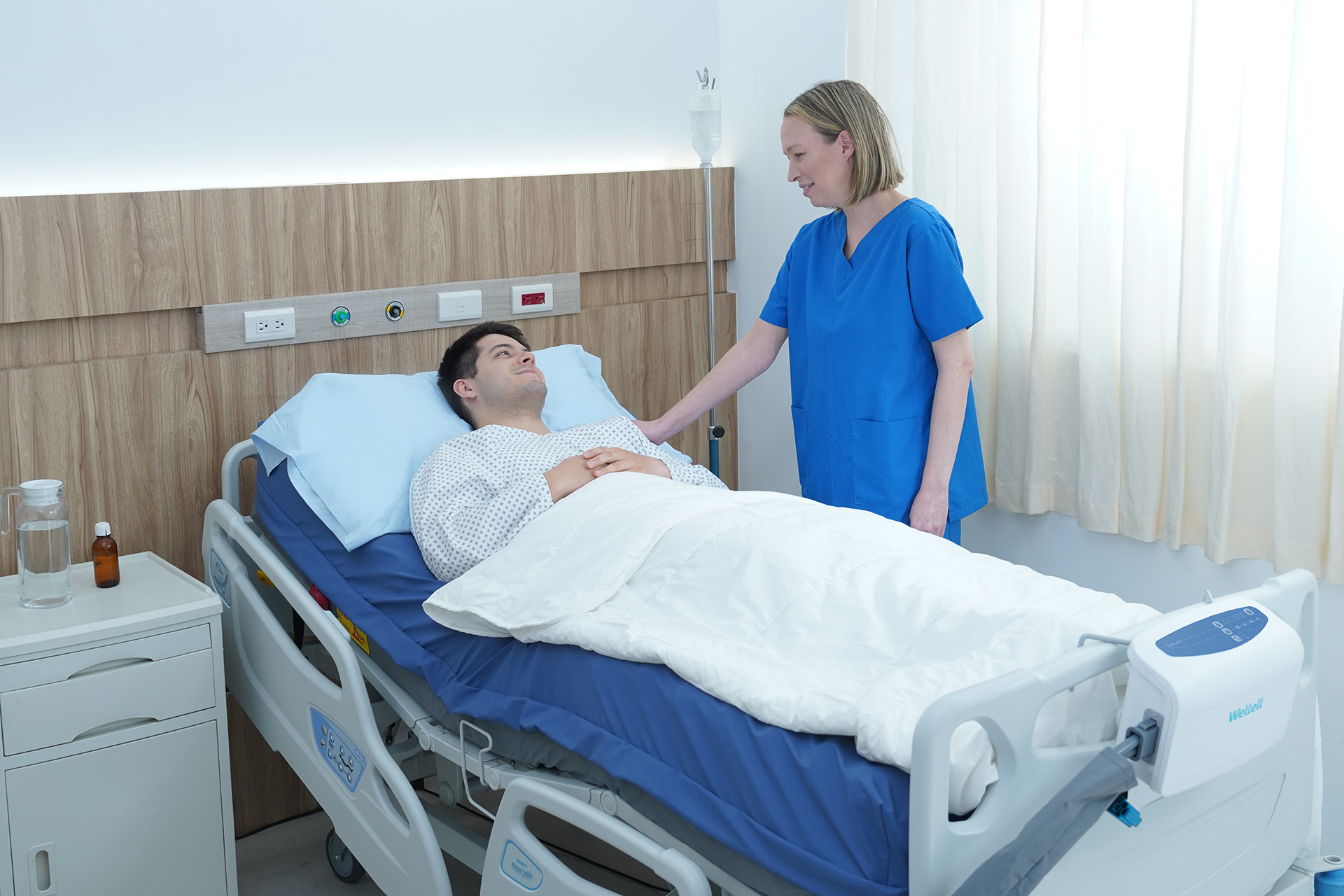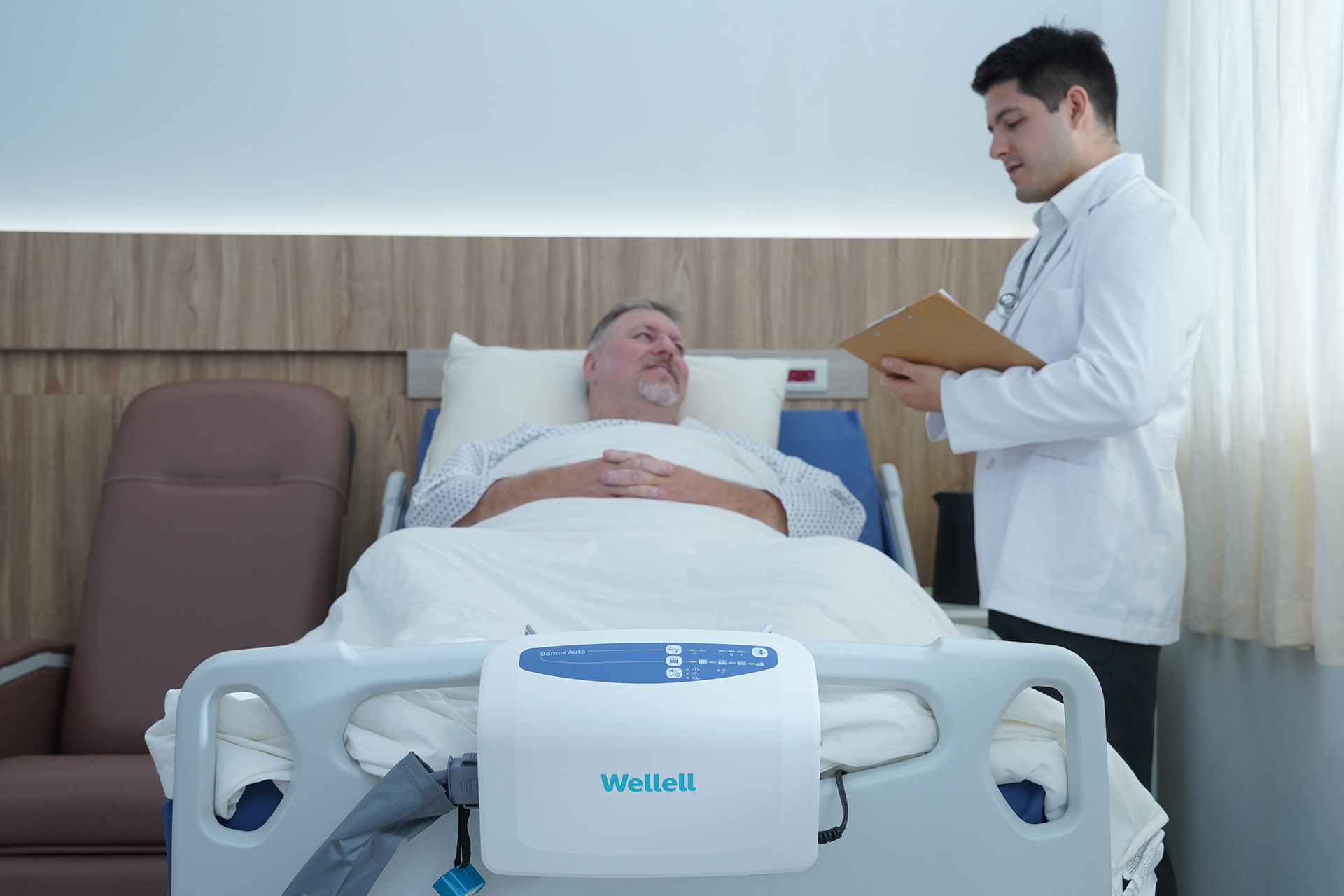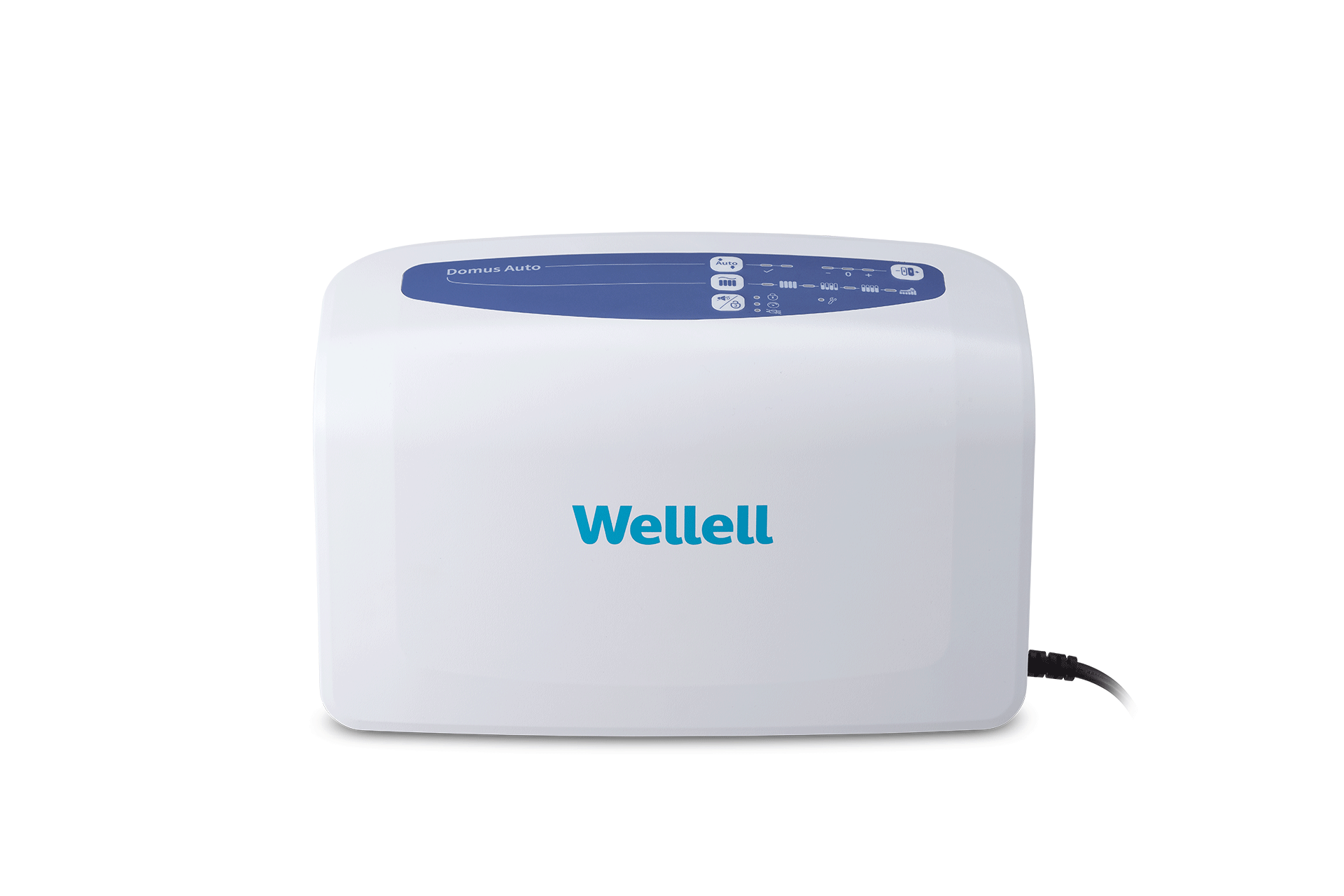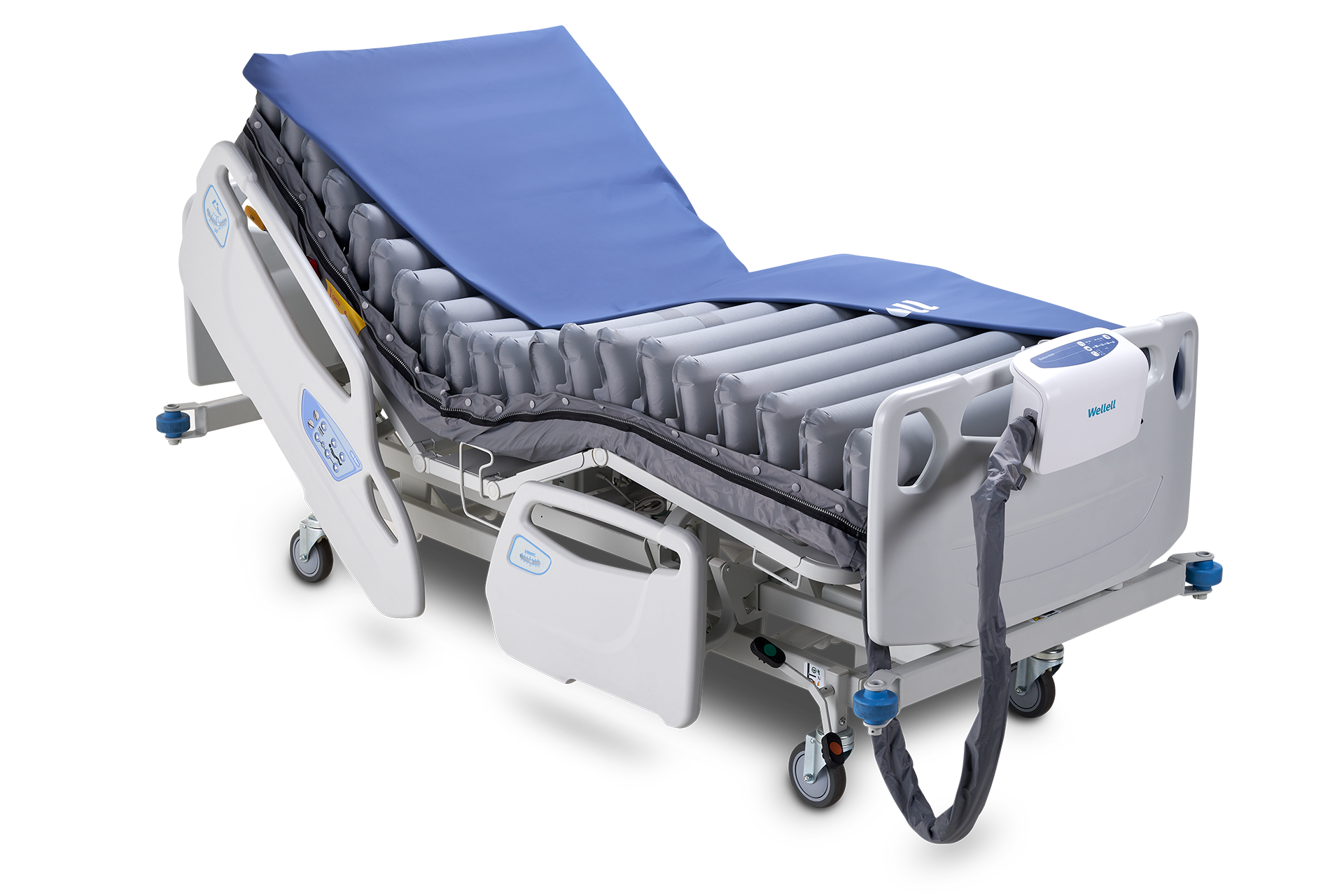Domus Auto
Auto-adjusting Air MattressFor Moderate to High Risk
Automatic Pressure Redistribution System for Optimizing Care Process
60% of aging, long-term care residents develop pressure injuries. The aging epidemic, longer life expectancy, and extensive need for assistive care raise pressure injury risk and burden for individuals and institutions.1-3
Many residents experience pressure-related discomfort, but undertrained and overworked staff tend to overlook their concerns, increasing complications, mortality risks, and nursing time and labor costs.4-6
Domus Auto’s automatic firmness calibration and manual refinement optimize early pressure injury prevention. Sacrum pressure relief allows individuals with different postures to sit longer and more comfortably.
- Related Links / Resources:
Case Study White Paper: Pressure Injury Prevention with Domus 4 & Domus Auto

Auto-adjust firmness, alternating surface
- Suitable for improving pressure injuries in long-term care and homecare residents.
- Provide effective pressure relief care with alternating pressure redistribution and constant low pressure modes.
- Automatic firmness adjustment based on residents' weight distribution for quick setup and pressure relief delivery.
- Max firm function provides a static firm surface for nursing procedures.
- Visual and audible alarm enhances patient safety and security.
- CPR knob allows caregivers to rapidly deflate the mattress for emergencies.

Automatically adjusts to the most optimal pressure for the patient, ensuring both clinical effectiveness and cost efficiency.

Tuning function improve patient comfort by manually micro-adjust mattress firmness.

Heel relief function provides easily remove the individual air-cell which can float the heels with zero pressure to prevent injuries on the heels.

Seat inflation mode adjusts the pressure of the air cells, helping prevent bottoming out while sitting, thereby improving stability and comfort.
| Domus Auto | ||
|---|---|---|
| Mattress Dimension (L x W x H ) | 78.7 x 31.4-43.3 x 5-8 in | 2000 x 800-1100 x 127-203 mm |
| Mattress Weight | 12.3-15.2 lb | 5.6-6.9 kg |
| Maximum Patient Weight | 440-550 lb | 200-250 kg |
| Pump Dimension (L x W x H ) | 11.4 x 7.3 x 5 in | 290 x 185 x 126 mm |
| Supply Voltage | 220-240 V / 50 Hz |
|

Auto-adjust firmness, alternating surface
- Suitable for improving pressure injuries in long-term care and homecare residents.
- Provide effective pressure relief care with alternating pressure redistribution and constant low pressure modes.
- Automatic firmness adjustment based on residents' weight distribution for quick setup and pressure relief delivery.
- Max firm function provides a static firm surface for nursing procedures.
- Visual and audible alarm enhances patient safety and security.
- CPR knob allows caregivers to rapidly deflate the mattress for emergencies.

Automatically adjusts to the most optimal pressure for the patient, ensuring both clinical effectiveness and cost efficiency.

Tuning function improve patient comfort by manually micro-adjust mattress firmness.

Heel relief function provides easily remove the individual air-cell which can float the heels with zero pressure to prevent injuries on the heels.

Seat inflation mode adjusts the pressure of the air cells, helping prevent bottoming out while sitting, thereby improving stability and comfort.
All air cells are made from Thermoplastic Polyurethanes (TPU). It is highly resistant to breaking down when in contact with water (hydrolysis), soft to touch, and minimizes friction and noise during patient movements.
The cover is made with nylon/PU and is vapor permeable, fire-resistant, and water-resistant. See specifications for more details on the fire-retardant standards.
- Kottner, J., Cuddigan, J., Carville, K., Balzer, K., Berlowitz, D., Law, S., Litchford, M., Mitchell, P., Moore, Z., Pittman, J., Sigaudo-Roussel, D., Yee, C. Y., & Haesler, E. (2019). Prevention and treatment of pressure ulcers/injuries: The protocol for the second update of the international Clinical Practice Guideline 2019. Journal of tissue viability, 28(2), 51–58. https://doi.org/10.1016/j.jtv.2019.01.001
- Jaul, E., Barron, J., Rosenzweig, J. P., & Menczel, J. (2018). An overview of co-morbidities and the development of pressure ulcers among older adults. BMC geriatrics, 18(1), 305. https://doi.org/10.1186/s12877-018-0997-7
- Demarré, L., Van Lancker, A., Van Hecke, A., Verhaeghe, S., Grypdonck, M., Lemey, J., Annemans, L., & Beeckman, D. (2015). The cost of prevention and treatment of pressure ulcers: A systematic review. International journal of nursing studies, 52(11), 1754–1774. https://doi.org/10.1016/j.ijnurstu.2015.06.006
- Jackson, D., Durrant, L., Bishop, E., Walthall, H., Betteridge, R., Gardner, S., Coulton, W., Hutchinson, M., Neville, S., Davidson, P. M., & Usher, K. (2017). Pain associated with pressure injury: A qualitative study of community-based, home-dwelling individuals. Journal of advanced nursing, 73(12), 3061–3069. https://doi.org/10.1111/jan.13370
- Song, Y., Hoben, M., Norton, P., & Estabrooks, C. A. (2020). Association of Work Environment With Missed and Rushed Care Tasks Among Care Aides in Nursing Homes. JAMA network open, 3(1), e1920092. https://doi.org/10.1001/jamanetworkopen.2019.20092
- Dealey, C., Posnett, J., & Walker, A. (2012). The cost of pressure ulcers in the United Kingdom. Journal of Wound Care, 21(6), 261–266. https://doi.org/10.12968/jowc.2012.21.6.261








